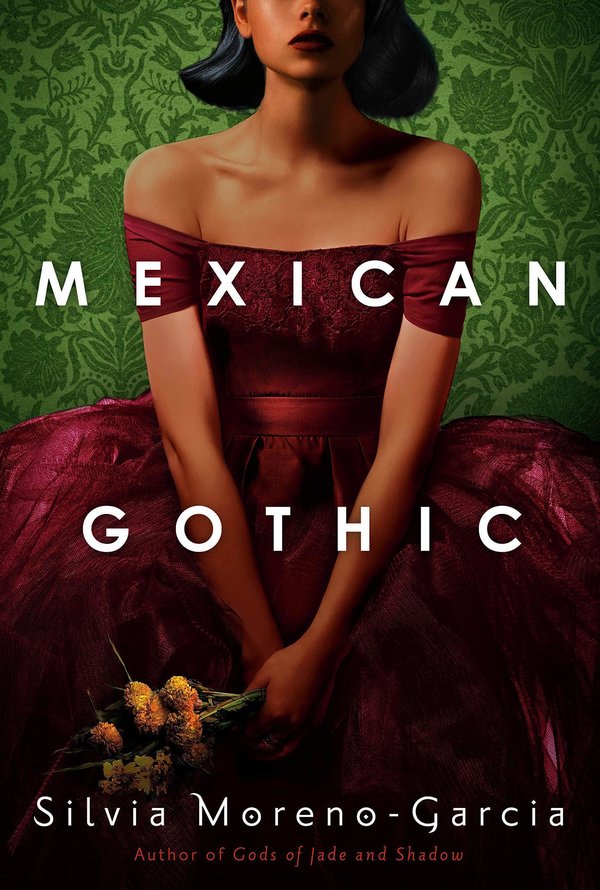
BOOK REVIEW: ‘Jane Eyre’ Meets ‘Dracula’ In This Sharp, Inventive ‘Mexican Gothic’ Tale
LISTEN
BY MAUREEN CORRIGAN
Gothic horror tales — from the short stories of Edgar Allan Poe to Jordan Peele‘s 2017 film Get Out — are almost always about escape. Run away! Run away from demons and haunted houses; from graveyards and ghouls; from racism and sexism.
Social criticism is embedded within the Gothic formula, a truth that Silvia Moreno-Garcia certainly appreciates. Her new novel, Mexican Gothic, is a ghastly treat to read, but this supernatural escape tale isn’t simply escapist. Set in Mexico in 1950, when women weren’t yet allowed to vote, Mexican Gothic explores how, for its independent female characters, marriage threatens to be a premature burial.
The heroine of Mexican Gothic is Noemí Taboada, a beautiful socialite given to wearing luscious full-skirted purple gowns and good furs. Noemí, we’re told, “was expected to devote her time to the twin pursuits of leisure and husband hunting.”

Mexican Gothic, by Silvia Moreno-Garcia
Glittering as she is, however, Noemí harbors ambitions to attend the National University for a masters in anthropology. Of course, her parents object. But, one night her father summons her home early from a party to offer her a deal: A year ago, Noemí’s orphaned cousin, Catalina, impulsively married a man from an old Anglo family who made their fortune long ago in silver mining. Catalina’s new husband whisked her off to a remote part of Mexico and little has been heard from her since. Now, however, a letter has arrived in which Catalina sounds insane, claiming she’s being poisoned and that the walls of the ancestral mansion are binding her with “threads like iron through [her] mind and … skin.” She begs Noemí to get her out.
Noemí’s father assumes this is just another case of female hysteria, but he doesn’t want the family name sullied by a divorce. He orders Noemí to travel to her cousin and calm her down. In return, he’ll consider allowing Noemí to attend the university. Noemí sets out on a mission to prove her worth to her father.
What ensues is an inspired mash-up of Jane Eyre, Ann Radcliffe’s The Mysteries of Udolpho, Dracula, Rebecca and that 1958 classic sci-fi movie, The Blob. Moreno-Garcia has a sharp ear for the slightly antiquated and sinister language of the Gothic. For instance, Noemí is picked up at the local train station by Catalina’s brother-in-law, a young man named Francis. Noemí will later describe him as, “very thin, his face … that of a plaster saint haunted by his impending martyrdom.”
The classic set piece scene where Noemí spies High Place, the family mansion, for the first time is also far from reassuring:
“… the house seemed to leap out of the mist to greet them with eager arms. It was so odd! It looked absolutely Victorian in construction, with its broken shingles, elaborate ornamentation, and dirty bay windows. …
It’s the abandoned shell of a snail, [Noemí] told herself …
Actually, it’s even more grotesque than that, as Noemí and we readers will find out. Inside, the mansion all is silent: The library is filled with rotting books; the windows locked and curtains drawn. Noemí thinks to herself that the silent house “was like a dress lined with lead.”
She’s mostly kept away from Catalina, who seems sedated, while Catalina’s charismatic husband grows increasingly lecherous in his attentions. But, by far, the most disturbing family member is the dying patriarch, Howard Doyle, who, we’re told, upon meeting Noemí, “vivisect[s] the young woman with his gaze” and declares, “You are much darker than your cousin, Miss Taboada.”
It turns out old Doyle is a raging eugenicist, one who believes mixed-race people like Noemí are inferior. But, perhaps, not without their uses.
Moreno-Garcia exquisitely paces this creeper so that as Noemí’s dread of the Doyle family mounts, so, too, does her fight-or-flight feminist resolve. The secret of High Place has to do with the exploitation of women, of native peoples by white interlopers, and with mushrooms, those fleshy fungi that thrive in the damp and dark.
Be forewarned: Like most contemporary horror tales, Mexican Gothic starts out suggestive and atmospheric, but becomes more grisly — shall we say, more meaty? — as it progresses. But, if you don’t mind some gore, it’s inventive and smart, injecting the Gothic formula with some fresh blood.
9(MDAyOTk4OTc0MDEyNzcxNDIzMTZjM2E3Zg004))















